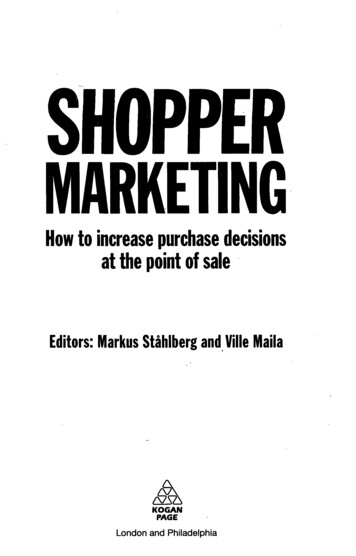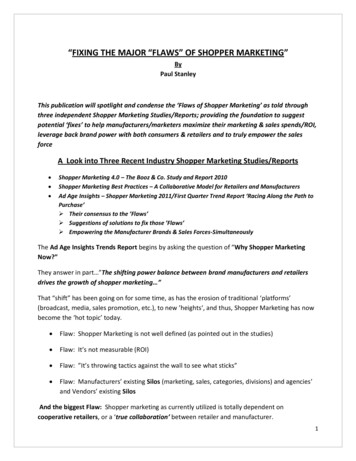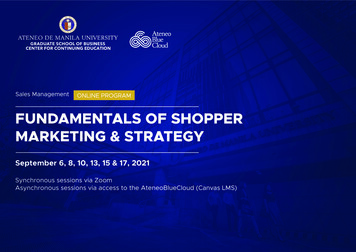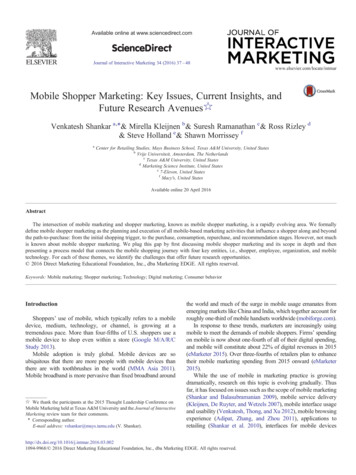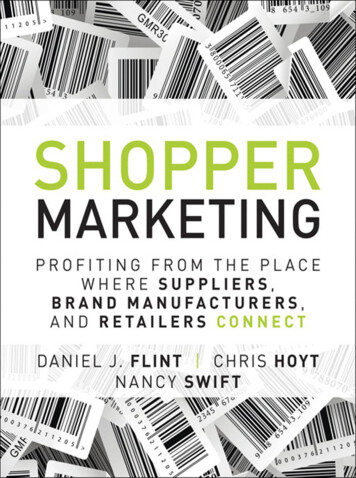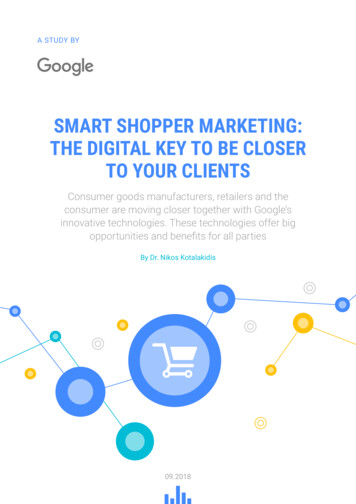
Transcription
A STUDY BYSMART SHOPPER MARKETING:THE DIGITAL KEY TO BE CLOSERTO YOUR CLIENTSConsumer goods manufacturers, retailers and theconsumer are moving closer together with Google’sinnovative technologies. These technologies offer bigopportunities and benefits for all partiesBy Dr. Nikos Kotalakidis09.2018
A STUDY BY GOOGLEExecutive SummaryThe Large Brand Manufacturers’ RenaissanceThe emergence of innovative start-ups, the expansion of private labels, drastic changes in consumerbehavior and the economic downturn in many emerging markets are four important factors contributing tothe current weak growth rates of large consumer goodsmanufacturers. However, the transformative power ofdigitization could free manufacturers from this difficultmarket scenario.GROWTH ENGINE DIGITIZATIONIn contrast to other industries digitization can leadto a renaissance of established companies in theFMCG world. Substantial financial and quality enhancing advantages can be found for these incumbentsthrough sales and marketing in particular. In order toexperience a growth spurt, manufacturers must leavedigital project pilots in the past and commit to digitizationon a broader level. Automatization, robotics, onlinecommunication, advanced analytics, and machinelearning along with the internet of things, VR/AR, blockchain and cloud technologies play a crucial role inachieving a growth in sales.Through the concentrated use of these technologies,the efficiency along the value chain increases, development times are reduced and consumer communicationcan become more targeted and individualized. Thechange towards digitization will be most noticeablein sales and marketing. Ordinarily, a large portion ofcompanies’ budgets are spent on trade marketing activities. However, these activities are only an indirect wayof communicating with the consumer. Through SmartShopper Marketing – the direct communication with theconsumer especially via mobile devices – manufacturersare able to overcome their limited communication withthe consumer and unlock new growth potentials.THREE CRITICAL ADVANTAGES OF SMARTSHOPPER MARKETINGThrough Smart Shopper Marketing, companies canbetter understand their customers, present theirbrand more favorably, and gain new possibilities to promote and measure sales. The key advantage to SmartShopper Marketing is the additional knowledge gained about the needs and behaviors of the consumer.Through digital methods of communication, manufacturers can generate their own data and reduce theinformation imbalance between what retailers knowand what manufacturers don’t know.New opportunities are emerging from advantages infour fields: cooperation with retailers online, cooperationwith retailers offline, manufacturers’ own online stores,PAGE 02
A STUDY BY GOOGLEand manufacturers’ own flagship stores. In particular,the establishment of manufacturers’ own sales channelsmeans that they learn more about their consumer because they own the data themselves. This in turn translates into an increased “Customer Lifetime Value”.MANUFACTURERS, RETAILERSAND CONSUMERS BENEFITBy employing innovative marketing methods acrossall sales channels, FMCG manufacturers can address and guide the consumer’s needs enabling additional sales, predominantly in retail stores. The consumer also benefits by receiving relevant messages atthe right moment saving them time and money, whileensuring the the best offer.In order for manufacturers to create this win-winscenario, they need to further develop their approachand adapt their organization through an integratedsales and marketing strategy as well as a massiveexpansion of technological competence. The traditionalseparation of sales and marketing has proven to beoutdated. The future belongs to combined teams inthe same location. Such a reorganization promotes anindispensable cultural change along with a change ofperspective within companies. Through this restructuring, the consumer moves to the center of all thinking andacting. By addressing the consumer’s needs and wants,large brand manufacturers can free themselves from thedifficulties of the current market. These companies holdthe digital key for a new era of growth in their hands.CHAPTER 1Turning Point: How Digitizationis Transforming the FMCG IndustryLarge brand manufacturers are facing declining market shares and sales.With digital technologies they can manage the turnaround and intensifythe relationship with their clients at the same time.CHANGING ENVIRONMENT: WHY THE FMCGBUSINESS IS STAGNATINGThe transformative power of digitization could proveto be a new engine of growth for the consumergoods industry and enable manufacturers to overcometheir current small growth rates and their lack of knowledge about the consumer. Between 2012 and 2016,sales of large consumer goods manufacturers onlyincreased by 0.7 percent per year. In the previous fiveyears, the industry showed an average growth of a full7.7 percent. The reasons for this stagnation includethe recession and currency drops in many emergingmarkets, the rise of innovative start-ups, a growingpopularity of private labels and changes in consumerbehavior.to anticipate tomorrow’s developments today. Thisinvolves digital technologies. The transformative powerof digitization can be the instrument for growth for theFMCG industry. Digital technologies reach the FMCGindustry later than many other economic branches.The most important sales channel for consumer goodsproducts, physical retail stores, have been competingwith digital attackers such as Alibaba and Amazon.However, technological innovations are now availableto the FMCG industry and many are being currentlytested. These technologies have the potential to revolutionize the value chain in the industry and traditionalbrand manufacturers still have the opportunity to usherin these changes.This study focuses on the most important and innovativearea of digitization for consumer goods companiesand how traditional brand manufacturers can catch upwith their digital competitors short term – online communication.A return to the path of growth will only be possible ifmanufacturers further develop their strategy and beginPAGE 03
A STUDY BY GOOGLEINNOVATION IN ONLINE COMMUNICATIONSummer, sun, lunch-break – with some ice-creamthis moment would be perfect. While this thoughtis still developing in the consumer’s head, a display adalready appears in the article that is currently beingread. “50-cent-coupon for an ice-cream of your choice”together with the hint that the next place to buy is only50 meters away. While this may sound like far-fetchedtechnology of the future, it is already possible todayusing geo-targeting and programmatic advertising tocreate the rare win-win-win scenario. The consumerenjoys without researching, manufacturers knowabout this additional sale first-hand and retailers ringthe cash register. Of course all of this is only possibleif the consumer has previously agreed in accordancewith the GDPR.For years brand manufacturers have shifted their branding budgets away from traditional mass media outletsto digital channels. In doing so, they have especiallyfollowed the changing media consumption behavior ofthe younger and middle-aged target groups. This trendwill continue in the upcoming years because with digital channels manufacturers can create more efficientadvertising and gain valuable data points, which theycan use, in return, to improve their ongoing and futuremarketing strategies.Although directly targeting the consumer could beone of the most innovative and efficient marketingmethods for manufacturers, most companies have yetto target the consumer individually. With new products,signals of purchase intent analyses, precise targetingof programmatic buying and the possibility of automated bidding, this field is constantly becoming moreimportant. Combined with the shift to mobile internet usage,shoppers have become more accessible tomanufacturers than ever. The basis for this individualaccessibility is Google's Artificial Intelligence: theunderlying algorithm that plays out, learns and continuously optimizes advertising.CHAPTER 2Smart Shopper Marketing:New Opportunities for Brand ManufacturersMore knowledge, more control and more possibilities to increase sales.Manufacturers benefit from digitization in multiple ways.RMoments before purchase47 %Hours before purchase26 %Days before purchase7%Weeks before purchase6%Months before purchase1%esearching, buying, consuming. What used to takedays or at least hours can now be done withinminutes. Smart devices have revolutionized shoppingand have made the consumer constantly accessible.For example, according to the Google Consumer Barometer every other German thinks about their grocerypurchase only right before visiting a store (figure 1).Another indication for the changing purchase behavior:the number of searches for a ‘supermarket near me’increased in Germany by 57 percent within one year.Similar developments can be observed for other FMCGproducts. These insights reveal that manufacturershave the opportunity to directly communicate with theconsumer right before a purchase. This is the conceptbehind Smart Shopper Marketing.FIGURE 1: When the consumer researches groceries in GermanyPAGE 04
A STUDY BY GOOGLEDIRECT DIGITAL COMMUNICATION BETWEENMANUFACTURER AND CONSUMERWhat is hiding behind this catchphrase? At the coreit is about establishing direct ways of communication between the manufacturer and the consumerthat is partially retailer-independent and doesn’t requirecooperation. This type of communication is mostly executed through digital channels and is mainly aimed at: Better understanding of the consumerBetter brand representationBetter opportunities to increase andmeasure salesWith direct digital communication, brand manufacturers hold the key to more efficient sales and marketingthrough enhanced knowledge about their customer.It is not only manufacturers who benefit, but also theconsumer who benefits through targeted marketingthat creates new stimulation in online and offline retailing. The consumer receives relevant information, hasa greater variety of products and can interact withbrands more easily.BENEFIT 1: BETTER UNDERSTANDINGOF THE CONSUMERMany brand manufacturers are in the dark withregard to their customers’ needs andeven moreso in regard to their customers’ actual behavior.The main reason: large shares of brand manufacturers’marketing budgets are spent on trade marketing, andretailers are only willing to share some information, if any,about the success of certain marketing activities. Throughdigital communication channels manufacturers havethe chance to generate their own data and to reduce thisinformation imbalance. More importantly, digital communication channels generate data in real-time to identifyand understand customer needs immediately.With this know-how manufacturers can secure multipleadvantages. These advantages include a more precisemeasurement of the marketing instruments’ performance and the identification of entry points fortargeted cross-selling. The more detailed the availableinformation is, the better manufacturers can plan theirstock and avoid empty shelf space. The customer datagained from digital communication can also play an important role in segmentation and portfolio optimization.BENEFIT 2: BETTER BRAND PRESENTATIONColor, logo, packaging size and claim: brand manufacturers employ experts that work on every detailto perfectly present a product. But when selling throughoffline and online retailers they usually lose controlover their brand’s presentation. This holds true forweekly leaflets sent out by large retail chains as wellas for the setting of the physical shelf space and theproduct’s website integration. The more manufacturersare able to reestablish direct contact to their customersthe greater the chances to avoid such stylistic incongruities. With flagship stores and websites, manufacturers can present their products in the right contextand guide the perception of their brand (figure 2).How brands want to present themselvesHow retailers present brands Best ShampooBUY NOW CHEAP!!!!!IN THE WORLD30%SALESPECIAL DISCOUNTOFFSPECIAL DISCOUNT10%OFF-15%LUXE and this how the shopper gets to see the brand.FIGURE 2PAGE 05
A STUDY BY GOOGLEBENEFIT 3: BETTER OPPORTUNITIES TOINCREASE AND MEASURE SALESWhen brand manufacturers establish their owncommunication and sales channels, the boundaries between production, marketing and sales increasingly begin to blur. These channels of communicationallow manufacturers to not only gain more information about their customers, but they also stimulate anincrease in sales. That is: with flagship stores and websites of their own, brand manufacturers can scale theirsales across their own sales channels and therebyreduce their dependence on retailers.TAKING ADVANTAGE OF ALL THREE BENEFITSWHILE REMAINING A VALUED PARTNER FORRETAILERS: AN EXAMPLEThe German consumer goods company Beiersdorf,owner of the Nivea brand, recognized the opportunities the digital age had to offer early on and intensified their direct contact with the consumer. In 2006,they opened their first Nivea-Haus in Hamburg, 95years after the product was developed. Now all of theirproducts are readily available in their own e-commercestore. Beiersdorf is also using this e-commerce storeto sell exclusive product lines that are only availableonline. Thanks to these offline and online stores, thecompany is better able to understand their customers’decisions and to better control their brand identity. Thepositive effect on sales is also not to be underestimated. Nevertheless, Nivea’s crucial partners remain retailers. And it has been shown that retailers also benefitgreatly from the extended knowledge gained by Nivea.Custom fitted promotions, better presentation and targeted advertising have all increased the sales both forBeiersdorf and for their retail partners.FOUR FIELDS OF ACTION: WHEREMANUFACTURERS CAN GAIN AN ADVANTAGEOnline or offline, through brands’ own stores orthrough retailers: new opportunities emergefor manufacturers in all four quadrants of Google’sPoint-of-Sale-Framework through Smart ShopperMarketing (figure 3)¹. There are two main approaches:working with online and offline merchants, which isprimarily about boosting sales, or brand’s own onlineshops and flagship stores, which make a decisive contribution to the continued development of companies’marketing and sales strategies. These approachesallow manufacturers to learn more about their customers and thus have the opportunity to sustainablyincrease their "Customer Lifetime Value".Increase SalesThird ailers # Sales, Sales Contract FulfilmentStrategy DevelopmentOwnerManufacturerABCDOwnOnline ShopsFlagshipStores Increasing CLV Better First Party Data CollectionFIGURE 3: Where New Opportunities Are Emerging for Consumer Goods CompaniesSource: ABCD Framework to activate the PoS through Smart Shopper Marketing¹ For more information visit: https://goo.gl/545mq6PAGE 06
A STUDY BY GOOGLEAONLINE RETAILERS: PRECISE TARGETEDCOMMUNICATIONEvery tenth Euro of German retail sales is nowaccounted for by online retailers, and 14 percentof all non-food items are purchased online. Accordingto the German Trade Association’s current OnlineMonitor, two out of three German citizens buy online, andthe rate of utilization is rapidly rising, especially amongolder people. As with banking, there is a shift awayfrom stationary and towards mobile Internet. Thirtypercent of online sales are already done on smartphonesand an additional 13 percent on tablets. Spontaneouspurchases and the desire to get a product as quicklyas possible are crucial factors when reaching for one’ssmartphone to shop.This changing consumer behavior is forcing consumergoods manufacturers to rethink their marketing strategies. Much more than before, manufacturers areable to influence the buying decisions at major onlineretailers such as Amazon and Alibaba.The influence manufacturers can have over buyingbehaviors is exactly why large electronic manufacturers count on and use Google’s Sponsored Product Ads(SPAs). SPAs are a new display ad format on an onlineretailer’s website. The advertising space is managed byGoogle’s algorithm. With targeted ads on online shops,manufacturers are able to remind the consumer abouttheir products, even if they would usually not appear onthe first page. On top of these targeted advertisements,with SPAs, manufacturers also automatically receiveall shopper data in their Google Ads Account, includingclick, basket and purchase data.An additional new product to improve sales andmarketing strategies is Google’s Co-funded ShoppingAds. These ads enable a manufacturer to book shoppingcampaigns for a specific retailer (with their permission);a practice that has been traditionally only possible forretailers themselves. With Co-funded Shopping Ads,the retailer benefits from additional traffic on theirwebsite, while the manufacturer receives the entireclick and purchase data collected by the retailer.While SPAs and Co-funded Shopping Ads are highlyeffective when the consumer has already decided tomake a purchase, food and cosmetics manufacturersare already entering the race for the consumer's atten-tion one step earlier. With online recipes or make-uptutorials, pioneers are already supporting their customers in everyday life. Chat-bots make such supporteasily available for the consumer enabling verbalinteraction without the need to pick up a smartphone.Google Home offers chat-bots a “home”. The interaction between man, machine and artificial intelligenceis constantly becoming more and more natural, intuitiveand easier.BMANUFACTURERS’ OWN ONLINE SHOPS:PRESENTING ONE’S BRAND PERFECTLYOf course, manufacturers can also directly enter thefast growing online trade. Many companies havebeen experimenting with their own online shops ontheir website.The benefits are obvious: in their own virtual storemanufacturers can present their products in a waythat suits them, and their brand, best. They can autonomously decide on pricing strategies and test outdifferent promotional activities. In addition, if manufacturers successfully guide enough visitors to theirwebsites, they also receive a considerable amount offirst party insights.However, there are three remaining challenges. Firstand foremost, the consumer usually buys an entirebasket of low-involvement articles like householdgoods and staple foods at once, and not just singleitems. Due to this, many online shops remain onlyniche offers. Second, customers have high expectationsregarding the functionality of a website and professionallogistics. Very few manufacturers are able to offer suchfunctionality and professional logistics without cooperating with external partners. Third, online and offlineretailers may interpret the start of manufacturers’ owne-commerce activities as an attack on their traditionaldomain. In order not to jeopardize established relationships, it is advisable to involve at least the largesttrading partners at an early stage.The better retailersunderstand why a manufacturer is setting up their ownonline shop, the more at ease they will be. The fact ofthe matter is: sound knowledge of customer behaviorbuilds the base for successful Smart Shopper Marketing.This serves manufacturers and retailers equally.PAGE 07
A STUDY BY GOOGLEThe example of one of the largest water producers,Nestlé, makes this clear. Nestlé Waters realized earlyon that a brand without its own online shop can notunderstand its customers from A to Z because the important information right before the purchase and atthe point of sale usually remains exclusive to retailers.In addition, the consumer today googles FMCG products for their daily needs making digital shelf spaceas important as the physical one.Against this background, Nestlé Waters set up anonline shop where private customers and businessclients can purchase various water brands directly orby subscription.By integrating an intelligent Google Search Ads marketing strategy into this new sales channel, Nestlé Waters lowered the cost per acquisition by more than 30percent. For example, among other things, Nestlé usedGoogle’s Geo-Targeting to advertise specifically inlocations with warm climates and high temperatures.All the information gathered on search, click and purchase behavior was used to optimize the marketingactivities and to target audiences that also have a highprobability of making a purchase. Not every consumerwill only purchase online; some will got to an actualstore. Physical retailers thus become additional beneficiaries of this digital advance.²In addition to Google Search, Nestlé can also use all other Shopper activations on the Display Network and onYouTube, such as TrueView for Shopping. TrueView forShopping, is optimized towards triggering a purchase,in this case, via a visit in Nestlé’s online store. This waythe user is approached holistically, and not exclusivelyon a single channel, when Google’s algorithm findsdirect or indirect signals that the user might be interested in buying water.COFFLINE RETAILERS: UNDERSTANDINGAND GUIDING CUSTOMER NEEDSWith over 10 percent of German retail sales attributed to e-commerce, 90 percent remain in thestores of major retailers. Smart Shopper Marketingenables brand manufacturers to set new stimulationoffline. This is especially relevant in moments wherethe consumer is searching for particular articles ontheir smart device or are in close proximity to a store.Geo-targeting on Google Search, display, or YouTube,beacons and wifi signals are readily available tools thatallow manufacturers to localize smartphone users. Inaddition, stock management tools provide a real-timeoverview of whether and in what quantity certain itemsare in stock in respective retail stores.Specifically, manufacturers are encouraged to enableAffiliate Location Extensions (free) in their Google Adsaccount. This feature shows shoppers which retailersclose to them have, listed in their supply, the productsearched for or advertised in a display ad or video.A large diaper brand, for instance, uses Affiliate LocationExtensions, as their starting point. They observed thatyoung parents don’t randomly search for their product,but are looking for a very specific article in a certainsize. By employing Affiliate Location Extensions, internet users were given information about the availabilityof the product in neighboring shops – and in real timeas they searched. This represents a real added valuefor stressed parents and is simultaneously the idealopportunity for retailers and manufacturers to increasetheir sales.But Smart Shopper Marketing is not limited to activitiesaround the point-of-sale. With YouTube’s Trueview forAction, for example, manufacturers can call attentionto promotions that are currently happening at a retailstore and herewith raise store traffic and sales and,of course, collect data. Alternatively, they can use thisformat to draw attention to a specific product or retailer information on their website.DFLAGSHIP STORES: WHEN MANUFACTURERSBECOME RETAILERSIn the digital era the boundaries between online andoffline business are beginning to blur. Large e-commerce retailers like Alibaba and Amazon are movingtowards owning physical stores, while almost none ofthe traditional retail chains are passing up on the opportunity of having their own online stores as well. Atthe same time retailers are increasingly pushing theirprivate labels into manufacturers’ traditional businessdomains. Consequently, manufacturers are counteringthis development by opening their own stores. Nikeis a prime example, as they opened their own storesforming a precedent throughout different branches.However the function and focus of these stores² For more information visit: https://goo.gl/9CrmMPAGE 08
A STUDY BY GOOGLEfor companies, like Nike or Beiersdorf with theirNivea-Haus, are not on building additional saleschannels, rather they are predominantly centered onlearning how customers react at the point of sale andbringing their brand experience to life.An exception is the coffee business. In the 1970’sEduscho and Tchibo, manufacturer and retailer, werealready closely interlocked. Since the 1990’s chainsfrom the US and the UK have been expanding worldwide. With the use of Geo-located Google Display Adsthe British coffee shop chain Costa Coffee recently increased their store traffic and guided people thirsty forcaffein away from a competitor’s store. On hot days theyadditionally advertised their cold drink product range –also precisely targeted geographically. Compared toprevious campaigns the reach was 82 percent and theclick-through-rate 32 percent higher. Interestingly, adetailed analysis of the campaign’s performance revealed that this campaign not only worked extremely wellfor the thirsty consumer, but also created a consumerdesire for an ice cold beverage simply by seeing the ad.³SMART SHOPPER MARKETING MEANS COMMUNICATING INTELLIGENTLY AND EFFICIENTLYalso benefits the consumer. Delivering the rightmessage at the right moment, saves the consumer time,by freeing them of the need to research, and money,by ensuring they get the best offers. The consumer’sirritation with generic marketing messages gives wayto the positive feeling that comes from being understood and supported in everyday life by manufacturers.THE NEXT GENERATION OF SMART SHOPPERMARKETING: A SIMPLE PICTURE MAKES WISHESCOME TRUEArtificial intelligence, machine learning and augmentedreality will create a whole new shopping experience inthe coming years. Google Lens offers an early taste ofthe currently used artificial intelligence. This innovationprovides relevant information to the user the momentthey direct their smartphone camera at a particularobject. Not only does it recognize the name of a product,but it also provides further information such as ratings,prices and reference locations – in short, everything apotential customer wants to know. For consumer goodsmanufacturers, this opens up completely new andessential possibilities for direct and highly targetedcustomer contact (figure 4).Four areas of action, one topic: Innovative marketingallows FMCG manufacturers to stimulate and steerthe needs of the consumer in order to realize additional sales – mainly in retail stores. Innovative marketingOk Google, Assistant opensLens opensObject InfoTap Lens iconTake pictureTake action likefurther infoor purchaceFIGURE 4: Your Google Assistant is one of many options to use Google Lens³ More under https://goo.gl/2F1imePAGE 09
A STUDY BY GOOGLECHAPTER 3Moments that Matter: Focusing onthe Consumer Means Focusingon the Micro MomentsTo win the consumer for their product, manufacturers must be there at the most decisive moments –from first interest to actual purchase. These are the “Moments that Matter.”4 Google has found fourkey moments that are of central importance for Smart Shopper Marketing in the FMCG industry.“I WANT TO BE.”-MOMENTThis moment is highly emotional and happens when aconsumer is in the mood to be entertained, inspired,surprised etc. It is a rather passive moment in terms ofpurchase intent, but still allows brand manufacturersto address the consumer in a perceptive state in orderto turn them on to their products. 90 percent of smartphone users aren't sure of the specific brand they wantto buy when they begin shopping. Thus, these momentsare a chance for advertisers and manufacturers to placetheir product at the forefront of the shopper’s mind.“IS THIS RIGHT FOR ME?”-MOMENTIn this moment, the consumer is actively looking foradditional information on a product to make sure it isthe right fit or them. This information could be onlineproduct reviews, questions on ingredients or allergens(e.g. “Is there lactose in cottage cheese”), questionsabout personal fit (e.g. “Is this the right moisturizerfor dry skin?”) or ethical fit (e.g. “Is there palm oil inthis product?”) of a product. These type of product fitsearches have experienced a steady increase in recentyears. For example, the number of searches for “glutenfree” or “palm oil” have quadrupled over the past fouryears.For low involvement products, active researching mightnot always occur, but that doesn’t mean the shopperis not looking for the right product to fit their needs.With Smart Shopper Marketing, brand manufacturerscan anticipate this moment of need enabling them to,for example, target health conscious fitness buffs withan ad for a high-protein ice cream bar on a hot day andexplain the nutritional details of the product.“I WANT TO GO/DO/BUY”-MOMENTIn this moment, the consumer shows a high purchaseintent and is actively looking for a store nearby, or a4good deal on a product. They are specifically lookingfor information on special offers, opening hours, proximity and ratings. They also want to know if a particular product is in stock, or if a service is offered. Theconsumer’s search for groceries and grocery storesare a prime example of this moment. The consumeris progressively searching for grocery products andstores on their smartphones. The number of searchesfor a ‘supermarket near me’ increased in Germany by57 percent within one year. And 61 percent of smartphone users say they are more likely to buy from companies whose mobile sites or apps customize information to their location. Connecting to the consumer, inthis moment, helps increase the mental availability ofa product immensely and can therefore contribute toa boost in sales. It is, thus, crucial that manufacturersmake desired information readily available and guidethe consumer to the online or offline point of sale.“HOW TO.?”-MOMENTIn this moment, the consumer is actively looking forsolutions and insights to their problems or needs, butdoes not necessarily have a specific product in mindyet. Unlike the “Is this right f
SHOPPER MARKETING Through Smart Shopper Marketing, companies can better understand their customers, present their brand more favorably, and gain new possibilities to pro-mote and measure sales. The key advantage to Smart Shopper Marketing is the additional knowledge gai-ned about the needs and behaviors of the consumer.
